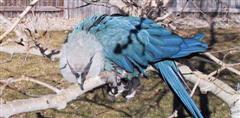Macaw - Severe
Chestnut-Fronted Scientific Name: Ara severa severa
Fri, 1st November, 2024 - 4:33 am GMT
Sponsor Ads:

Alternative Name
Chestnut-Fronted Scientific Name: Ara severa severaBasic Info
The Chestnut Fronted Macaw is about a foot and a half in length and is crowned with a line of chestnut colored feathers across the forehead. The plumage is primarily metallic green, and the crown is blue. The shoulders are red. Severe Macaws have blue flight and tail feathers with red undersides. Their bare facial patch exhibits delicate feather lines, the chin is a dark reddish brown, and the underside of the tail is a dark chestnut color. The bill is black and the feet are dark gray. Severe Macaws have orange irises. The wingspan of Chestnut-Fronted Macaws is eight and a half to nine and a half inches. When setting up pairs, Severe Macaws must be sexed using DNA or surgical methods. Immature Severe Macaws will have blacker colored bands on the foreheads, as the chestnut color develops with maturity, and you may use this indicator to determine the bird's breeding capabilities.
Health
Severe Macaws do well when fed on a variety of foods, as well as commercial pellets. Pasta, beans, pine nuts, and porridge all make fine treats for Severe Macaws. Severe Macaws do best if kept in pairs within hearing distance of each other. They are quite noisy and need lots of attention to prevent loneliness and depression. Breeding In captivity, Severe Macaws are quite prolific if paired correctly. They may clutch multiple times in a year and clutches usually consist of about five eggs, which hatch in 26 to 28 days. Immature Severe Macaws have a blackish feather band on the forehead, duller plumage, and a darker iris. Hand fed Severe Macaws make the best, tamest pets. It should be noted that, like many other parrots, the Severe Macaw might become more aggressive towards people if it has bonded with another macaw. This is especially true if they are taken away from their cage-mates. If you want your Severe Macaw to form a close human bond, it should not be allowed to bond with another Severe Macaw.Habitat
N/ABehavior
With a colorful personality, the Severe Macaw or Chestnut-Fronted Macaw is all the fun of a large Macaw rolled into a smaller package! The Severe Macaw is extremely social and loves to mimic speech and be petted and played with! Best if kept in pairs, Severe Macaws are quite intelligent and should be provided with ropes to swing on and lots of wood to chew, for they can get quite destructive if bored. Forming strong bonds with their keepers, they are affectionate, silly, and active, and love to climb, explore, and hang upside down, chatting and squawking often. Chestnut-Fronted Macaws relate to their world by chewing on it, and this may include you! They should be taught early on to regulate the pressure of their beaks. Because of their smaller size, Severe Macaws will do well in a cage for African Grey Parrots, however, be sure it is sturdy and do not give these birds toys intended for small birds!Origin
South AmericaHistory
Severe Macaws are native to northern Venezuela up through the Guyanas and south to northeast Brazil. They are little known as companion animals though they make wonderful family pets when captive bred and hand raised and remain quite rare.Common Foods
They do well when fed on a variety of nuts, seeds, fruits, vegetables, green food, and commercial pellets. Pasta, beans, pine nuts, and porridge all make fine treats for Severe Macaws.Sponsor Ads:
"Those who were called skillful leaders of old knew how to drive a wedge between the enemy's front and rear; to prevent co-operation between his large and small divisions; to hinder the good troops from rescuing the bad, the officers from rallying their men." -- Sun Tzu, The Art of War
Macaw - Severe
Coded by: BGID® | ALL RIGHTS RESERVED Copyright © 2000-2024
Disclaimer | Privacy | Report Errors / Contact | Credits








 Homosexual behavior stems from the mind or genetics?
Homosexual behavior stems from the mind or genetics?  The Best Text Adventure You Will Ever Play! The official site:
The Best Text Adventure You Will Ever Play! The official site:  Why haven't we as a collective earth met with aliens yet?
Why haven't we as a collective earth met with aliens yet?  World EcoSystem - Biodiversity Changes - Who is on board and who isn
World EcoSystem - Biodiversity Changes - Who is on board and who isn  Mouthwash - Mouthrinse - Mouth Sores - Healing Infections - Gingivitis
Mouthwash - Mouthrinse - Mouth Sores - Healing Infections - Gingivitis  Treatment for Depression
Treatment for Depression  Ultra radical and violent Islamist group that even rivals Al Qaeda
Ultra radical and violent Islamist group that even rivals Al Qaeda  An idea to have teachers who want to carry guns to school undergo some level of police training will be left up to local school districts and police departments.
An idea to have teachers who want to carry guns to school undergo some level of police training will be left up to local school districts and police departments.